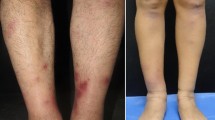Abstract
We evaluated finger skin temperature in 36 patients affected by Raynaud's phenomenon with or without anticentromere antibody positivity. The temperature measured under basal conditions and after dipping the finger in water at 10°C for 5 min was similar in both groups; the temperature at the end of an 18-min recovery period was significantly lower in anticentromere antibody positive patients. This observation suggests a persistent digital vasospasm after the cold test in patients suffering from Raynaud's phenomenon with anticentromere antibody positivity. This autoantibody seems to identify a subgroup of patients affected by Raynaud's phenomenon with a severe involvement of the microcirculation.
Similar content being viewed by others
References
Kahaleh MB (1994) Raynaud's phenomenon and vascular disease in scleroderma. Curr Opin Rheumatol 6:621–627
Zamora MR, O'Brien RF, Rutherford RB, Weil JV (1990) Serum endothelin-1 concentrations and cold provocation in primary Raynaud's phenomenon. Lancet 336:1144–1147
Bunker CB, Terenghi G, Springall DR, Polak JM, Dowd PM (1990) Deficiency of calcitonin gene-related peptide in Raynaud's phenomenon. Lancet 336:1530–1533
Marasini B (1994) Raynaud's phenomenon. Semin Clin Immunol 7:33–40
Belch JJF (1991) Raynaud's phenomenon. Curr Opin Rheumatol 3:960–966
LeRoy EC, Krieg T, Black C, Medsger TA Jr, Fleischmajer R, Rowell N, Jablonska S, Wollheim F (1988) Scleroderma (systemic sclerosis): classification, subsets and pathogenesis. J Rheumatol 15:202–205
Weiner ES, Earnshaw WC, Senécal J-L, Bordwell B, Johnson P, Rothfield NF (1988) Clinical association of anticentromere antibodies and antibodies to topoisomerase I. A study of 355 patients. Arthritis Rheum 31:378–385
Ferri C, Bernini L, Cecchetti R, Latorraca A, Marotta G, Pasero G, Neri R, Bombardieri S (1991) Cutaneous and serologic subsets of systemic sclerosis. J Rheumatol 18:1826–1832
Giordano M, Valentini G, Migliaresi S, Picillo U, Vatti M (1986) Different antibody patterns and different prognoses in patients with scleroderma with various extent of skin sclerosis. J Rheumatol 13:911–916
Wigley FM, Wise RA, Miller R, Needleman BW, Spence RJ (1992) Anticentromere antibody as a predictor of digital ischemic loss in patients with systemic sclerosis. Arthritis Rheum 35:688–692
Caramaschi P, Biasi D, Manzo T, Carletto A, Poli F, Bambara LM (1995) Anticentromere antibody — clinical associations. A study of 44 patients. Rheumatol Int 14:253–255
Tan EM, Cohen AS, Fries JF, Masi AT, McShane DJ, Rothfield NF, Schallenberg JG, Talal N, Winchester RJ (1982) The 1982 revised criteria for the classification of systemic lupus erythematosus. Arthritis Rheum 25:1271–1277
Vitali C, Bombardieri S, Moutsopoulos HM, Balestrieri G, Bencivelli W, Bernstein RM, Bjerrum KB, Braga S, Coll J, De Vita S, Drosos AA, Ehrenfeld M, Hatron PY, Hay EM, Isemberg DA, Janin A, Kalden JR, Kater L, Konttinen YT, Maddison PJ, Maini RN, Manthorpe R, Meyer O, Ostuni P, Pennec Y, Prause JU, Richards A, Sauvezie B, Schiodt M, Sciuto M, Scully C, Schoenfeld Y, Skopouli FN, Smolen JS, Snaith ML, Tishler M, Todesco S, Valesini G, Venables PJW, Wattiaux MJ, Youinou P (1993) Preliminary criteria for the classification of Sjögren's syndrome: results of a prospective concerted action supported by the European Community. Arthritis Rheum 36:340–347
Caramaschi P, Codella O, Poli G, Perbellini L, Biasi D, Bambara LM, Corrocher R, De Sandre G (1989) Use of computerized digital thermometry for diagnosis of Raynaud's phenomenon. Angiology 40:863–872
Bovenzi M (1988) Vibration white finger,digital blood pressure, and some biochemical findings on workers operating vibrating tools in the engine manufacturing industry. Am J Ind Med 14:575–584
Brennan P, Silman A, Black C, Bernstein R, Coppock J, Maddison P, Sheeran T, Stevens C, Wollheim F (1993) Validity and reliability of three methods used in the diagnosis of Raynaud's phenomenon. Br J Rheumatol 32:357–361
Maricq HR, Diat F, Weinrich MC, Maricq JG (1994) Digital pressure responses to cooling in patients with suspected early vs definite scleroderma (systemic sclerosis) vs primary Raynaud's phenomenon. J Rheumatol 21:1472–1476
Leesmans E, Bartelink ML, Wollersheim H, Thien T (1993) The relationship between subjective vasospastic complaints and finger blood flow measurements in Raynaud's phenomenon. Neth J Med 43:13–17
Albrecht HP, Hiller D, Hornstein OP, Buhler-Singer S, Muck M, Gruschwitz M (1993) Microcirculatory functions in systemic sclerosis: additional parameters for therapeutic concepts? J Invest Dermatol 101:211–215
Van de Wal HJCM, Wijn PFF, Van Lier HJJ et al. (1987) Noninvasive hemodanymic assessment of vasospasm in patients with primary Raynaud's phenomenon. Angiology 38:315–331
Codella O, Caramaschi P, Olivieri O, Perbellini L, Perbellini A, Bambara LM, Corrocher R, De Sandre G (1989) Controlled study between ketanserin and nifedipine in 28 patients suffering from Raynaud's phenomenon. Angiology 40:114–121
Bogadi-Sara A, Zavalic M (1994) Diagnostic value of finger thermometry and photoplethysmography in the assessment of hand-arm vibration syndrome. Int Arch Occup Environ Health 66:137–140
Bovenzi M (1987) Finger thermometry in the assessment of subjects with vibration-induced white finger. Scand J Work Environ Health 13:348–351
Bartelink ML, Wollersheim H, Jansen RW, Theeuwes A, Thien T (1993) Reproducibility of the finger cooling test. Microvasc Res 45:65–73
Bovenzi M (1988) Finger systolic pressure during local cooling in normal subjects aged 20 to 60 years: reference values for the assessment of digital vasospasm in Raynaud's phenomenon of occupational origin. Int Arch Occup Environ Health 61:179–181
Horsfall AC (1995) Autoantibodies and autoimmune disease: cause or consequence? Rheumatol Eur 24 [Suppl 2]:13–17
Wigley FM, Seibold JR, Wise RA, McCloskey DA, Dole WP (1992) Intravanous iloprost treatment of Raynaud's phenomenon and ischemic ulcers secondary to systemic sclerosis. J Rheumatol 19:1407–1414
Fiessinger JN, Schäfer M (1990) Trial of iloprost versus aspirin treatment for critical limb ischemia of thromboangiitis obliterans. Lancet 335:555–557
Author information
Authors and Affiliations
Rights and permissions
About this article
Cite this article
Caramaschi, P., Biasi, D., Carletto, A. et al. Finger skin temperature in patients affected by Raynaud's phenomenon with or without anticentromere antibody positivity. Rheumatol Int 15, 217–220 (1996). https://doi.org/10.1007/BF00290524
Received:
Accepted:
Issue Date:
DOI: https://doi.org/10.1007/BF00290524




